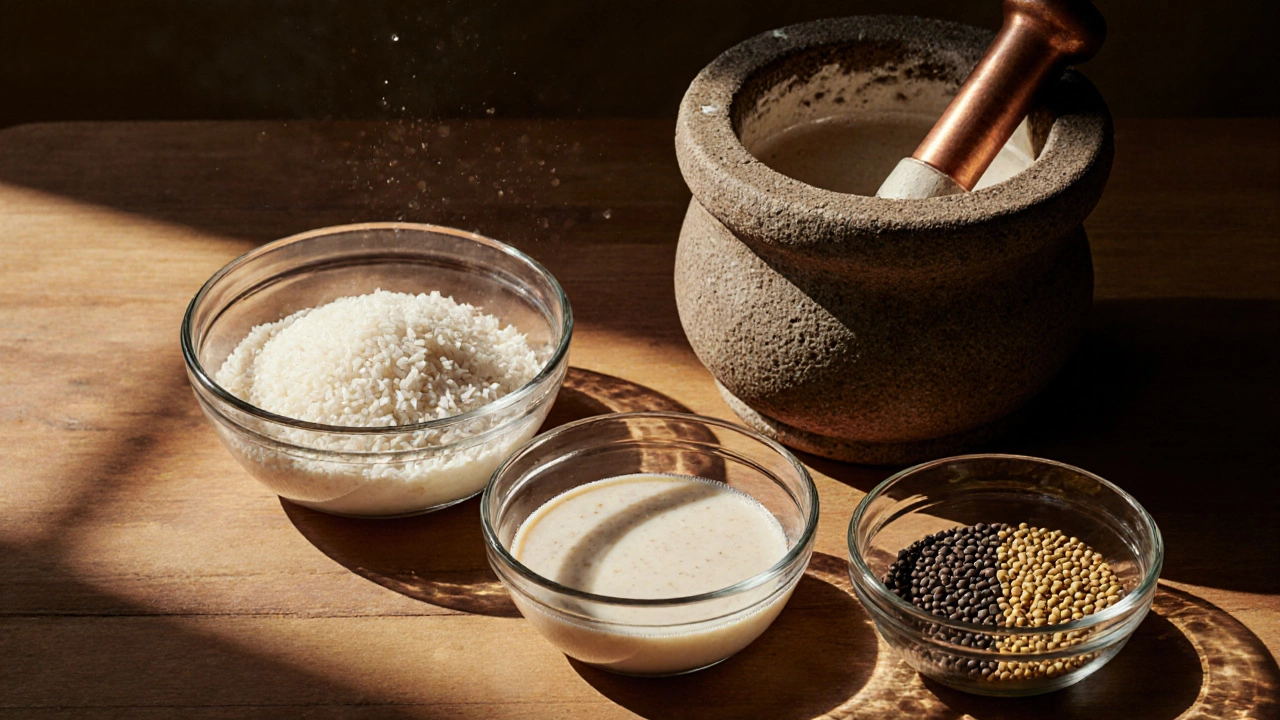Baking Soda Dosa – Quick, Fluffy South Indian Breakfast
When working with Baking Soda Dosa, a rapid‑rise version of the classic fermented crepe that uses baking soda as a leavening agent. Also known as instant dosa, it brings the tang of traditional batter without the overnight wait.
Dosa batter, a mixture of rice, urad dal, and water that forms the base for all dosa styles is the foundation. Normally it relies on fermentation, a natural process where microbes produce carbon dioxide, giving the batter its airy texture. By adding baking soda, you shortcut that process—your batter gets a quick lift, letting you serve fluffy dosas in under half an hour. This technique is especially handy for busy mornings or when you don’t have a warm kitchen for a long ferment.
Why Use Baking Soda?
The main advantage of baking soda is speed. It reacts instantly with the acidic components in the batter—usually a splash of yogurt or a pinch of lemon juice—to create carbon dioxide bubbles. Those bubbles puff up the batter, so the cooked crepe separates easily from the pan and develops that signature soft‑and‑crisp edge. baking soda dosa also keeps the flavor profile familiar, because you still use the same rice‑urad base, just with a modern twist.
Another benefit is consistency. Traditional fermentation can be unpredictable; temperature changes affect the microbial activity, leading to variable texture. With baking soda, you control the rise by adjusting the amount—typically ¼ tsp per cup of batter. This predictable lift means you can plan a full breakfast spread without worrying that some dosas will turn out flat.
South Indian cuisine, the cultural backdrop for dosas, loves balance. The tang from fermentation, the heat from the skillet, and the delicate crunch of the edges all play together. By swapping long fermentation for a quick leavening agent, you preserve that balance while saving time. The result feels authentic enough to serve to guests who expect a classic thali, yet it fits modern schedules.
Practical tips make the difference between a soggy pancake and a restaurant‑quality dosa. First, grind the rice and urad dal to a smooth, slightly coarse paste—not too fine, or the batter will become gluey. Second, let the blended batter rest for 10‑15 minutes after adding baking soda; this gives the chemical reaction a moment to develop. Third, heat the skillet to medium‑high and drizzle a few drops of oil—too little oil and the dosa sticks, too much and it loses its crisp edge.
Variations are easy. Add a handful of chopped onions, green chilies, or cilantro to the batter for a flavored version. For a healthier spin, substitute part of the rice with wheat flour or oats; the baking soda still works because the acidity comes from the added yogurt. Even sweet versions exist—mix in a spoonful of jaggery and a pinch of cardamom for a dessert‑style dosa that pairs well with fresh fruit.
Below you’ll find a curated list of articles that dig deeper into the science of leavening, compare traditional vs. instant dosa methods, and share step‑by‑step recipes. Whether you’re a newbie looking for a quick breakfast or an experienced cook wanting to streamline your menu, the posts will give you actionable insights to master the baking soda dosa and its many twists.

Why Add Soda to Dosa Batter? Benefits, Ratios & Tips
Discover why a pinch of soda improves dosa batter, the right ratios, alternatives, and troubleshooting tips for perfect crispy dosas every time.
- Chutney Recipes (13)
- General (11)
- Healthy Living (10)
- Easy Indian Recipes (9)
- Chicken Curry Recipes (9)
- Healthy Indian Snacks (8)
- Paneer Recipes (7)
- Dal Recipes (7)
- Street Food (7)
- Dosa Recipes (7)
-
Can I Make Paneer from Broken Milk?
4 Apr 2025 -
Biryani and Your Body: What Really Happens After That Feast
4 Jun 2025 -
What Makes Chicken Curry Taste Better?
20 Mar 2025 -
Thick vs Thin Roti: The Ultimate Guide to Perfect Indian Flatbread
1 Aug 2025 -
Why Eating Pulses at Night Might Not Be the Best Idea
12 Apr 2025
17.10.25
Kaia Binari
0